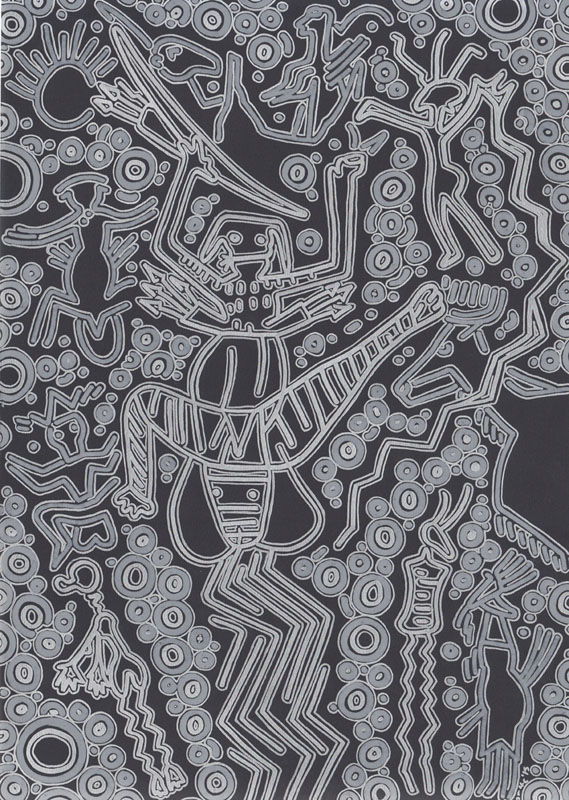This evolutionary picture, pioneered by Chris Knight and expanded with Camilla Power and several others, of cognitively-transforming humans gaining collective and symbolic identity is a subtle and reasoned narrative that emerges from strictly Darwinian sexual selective pressures, but which nonetheless maintains a lively sense of the sacred throughout. In case the semi-mythical nature of the model should cause one to think it fantasy, however, it should be noted that this 'Female Cosmetic Coalitions' hypothesis, bears significant predictive power upon the fields of archaeology as pertaining to the Middle Stone Age in Africa and possibly Europe, as well as upon the ethnography of modern hunter-gatherer populations the world over.
|
If the model outlined in the previous chapter seems somewhat speculative, this chapter presents an array of illustrative evidence, and demonstrates the genuine multi-disciplinarity of the evolutionary ideas discussed. Chris Knight and Camilla Power separately present a great deal more evidence than I offer here, but what is perhaps demonstrated in this chapter is an invitation into an expanded image of the human being, in that we begin to see more clearly that our apparently separate categories of human behaviour – visionary experience, religion, language, menstruation, sexual behaviours, symbolic culture – participate in a much more interconnected reality than we are perhaps accustomed to considering. This holistic experience of our humanity will be developed further in later chapters…
This evolutionary picture, pioneered by Chris Knight and expanded with Camilla Power and several others, of cognitively-transforming humans gaining collective and symbolic identity is a subtle and reasoned narrative that emerges from strictly Darwinian sexual selective pressures, but which nonetheless maintains a lively sense of the sacred throughout. In case the semi-mythical nature of the model should cause one to think it fantasy, however, it should be noted that this 'Female Cosmetic Coalitions' hypothesis, bears significant predictive power upon the fields of archaeology as pertaining to the Middle Stone Age in Africa and possibly Europe, as well as upon the ethnography of modern hunter-gatherer populations the world over.
2 Comments
I am delighted to announce the forthcoming publication of my book, entitled 'On Vision and Being Human: Exploring the Menstrual, Neurological and Symbolic Origins of Religious Experience'. This beautifully-presented 340-page book represents the completed form of the 'On Vision & Being Human' essay whose first draft chapters are being serialised here on Archaic Visions. As will perhaps be familiar to regular readers of this blog, the book explores the problems presented by visionary experience in the modern world, and suggests our propensity for symbolic cognition as a way to come to a new understanding of the human being in the twenty-first century as living in two different worlds, one of scientific evidence and one of imaginative colour.
The book is adorned with 30 beautiful monochrome visionary illustrations, and is supplemented with interesting endnotes and detailed references and annotations. It is being published by my own personal publishing imprint, Xibalba Books. Of course, the first draft will continue to be serialised here, but the final form of the completed essay along with all the extras is in the book! The publication date is November 1st 2015 but preorders will be available from September 1st from this page - www.biroz.net/xibalbabooks/book-on-vision.htm. 'On Vision and Being Human' will also be available from Lulu, Amazon, Barnes & Noble and other notable outlets from Autumn 2015. It might seem, at first glance at least, that in tracing a path back to the evolutionary origins of our species, cognitively-modern Homo sapiens sapiens, some 180,000 years ago in the African Middle Stone Age, we have wandered far from our original theme of visionary experience. But as we have seen, visionary experience is just one element which partakes in the wider phenomenon of human symbolic cognition, and when we begin to look into how that could have evolved, we begin to sense the outlines of how the 'Otherness' of vision, and its perceptual ambiguities, could have arisen. With patience, over the next few chapters, we will see how this lengthy Darwinist (and, in time, ethnographic) excursion will throw a completely new light upon our visionary subject, beginning here with a subtle, complex and strange but powerfully predictive hypothesis from evolutionary psychology - the Female Cosmetic Coalitions model... One of the perennial themes that emerges from even a casual glance of the australopithecine and hominid fossil record is a marked increase in brain size from a decidedly chimplike 350-500 cubic centimetres in Australopithecus afarensis (whose remnants include the famous 'Lucy' fossil) to around 1200-1600 cubic centimetres in anatomically-modern humans. This process, known as encephalization, was not however a steady, continuous one: rather there were two periods over which hominid brains appear to have taken major leaps in volume, the first being some two to one-and-a-half million years ago with the emergence of Homo ergaster, and the second between five and two hundred thousand years ago with the evolution of archaic Homo sapiens from ancestral populations of Homo heidelbergensis in Eastern and Southern Africa. It is the second of these periods which interests us here.
|
ARCHAIC VISIONS
|







 RSS Feed
RSS Feed






